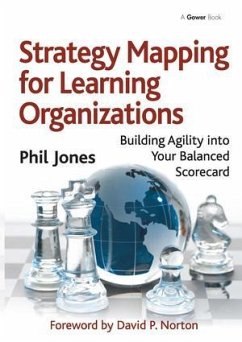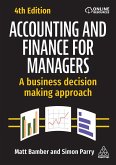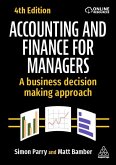Phil Jones (UK Institute of Education)
Strategy Mapping for Learning Organizations
Building Agility into Your Balanced Scorecard
Phil Jones (UK Institute of Education)
Strategy Mapping for Learning Organizations
Building Agility into Your Balanced Scorecard
- Gebundenes Buch
- Merkliste
- Auf die Merkliste
- Bewerten Bewerten
- Teilen
- Produkt teilen
- Produkterinnerung
- Produkterinnerung
How can we ensure our strategy will succeed, especially in changing and uncertain times? This book answers this question by explaining that you need to become a more responsive organization - one that captures its strategy in strategy maps, learns from that strategy and can adapt to deliver results.
Andere Kunden interessierten sich auch für
![Financial Information Analysis Financial Information Analysis]() Philip O'ReganFinancial Information Analysis84,99 €
Philip O'ReganFinancial Information Analysis84,99 €![The Routledge Companion to Accounting History The Routledge Companion to Accounting History]() The Routledge Companion to Accounting History271,99 €
The Routledge Companion to Accounting History271,99 €![Accounting and Finance for Managers Accounting and Finance for Managers]() Matt BamberAccounting and Finance for Managers167,99 €
Matt BamberAccounting and Finance for Managers167,99 €![Accounting and Finance for Managers Accounting and Finance for Managers]() Matt BamberAccounting and Finance for Managers112,99 €
Matt BamberAccounting and Finance for Managers112,99 €![The Routledge Companion to Accounting History The Routledge Companion to Accounting History]() The Routledge Companion to Accounting History51,99 €
The Routledge Companion to Accounting History51,99 €![Financial Failures and Scandals Financial Failures and Scandals]() Krish BhaskarFinancial Failures and Scandals27,99 €
Krish BhaskarFinancial Failures and Scandals27,99 €![Strategy Maps Strategy Maps]() Robert S. KaplanStrategy Maps42,99 €
Robert S. KaplanStrategy Maps42,99 €-
-
-
How can we ensure our strategy will succeed, especially in changing and uncertain times? This book answers this question by explaining that you need to become a more responsive organization - one that captures its strategy in strategy maps, learns from that strategy and can adapt to deliver results.
Produktdetails
- Produktdetails
- Verlag: Taylor & Francis Ltd
- Seitenzahl: 340
- Erscheinungstermin: 28. November 2011
- Englisch
- Abmessung: 250mm x 175mm x 23mm
- Gewicht: 762g
- ISBN-13: 9780566088117
- ISBN-10: 0566088118
- Artikelnr.: 42346577
- Herstellerkennzeichnung
- Libri GmbH
- Europaallee 1
- 36244 Bad Hersfeld
- gpsr@libri.de
- Verlag: Taylor & Francis Ltd
- Seitenzahl: 340
- Erscheinungstermin: 28. November 2011
- Englisch
- Abmessung: 250mm x 175mm x 23mm
- Gewicht: 762g
- ISBN-13: 9780566088117
- ISBN-10: 0566088118
- Artikelnr.: 42346577
- Herstellerkennzeichnung
- Libri GmbH
- Europaallee 1
- 36244 Bad Hersfeld
- gpsr@libri.de
Phil Jones has helped organizations improve how they manage strategy and performance in the UK, Europe, US and Far East, including organizations in sectors as diverse as Banking, Charities, Manufacturing, Local Government, Utilities, Social Care, Retail, Health, Defence and Professional Services. They have ranged from start-ups to multi-national listed organizations. Phil is a consultant, author and speaker on strategy, performance and behaviour in organisations. He worked for Norton & Kaplan (authors of the original balanced scorecard books) for over four years and now runs his own research based consultancy, Excitant Ltd.
I: Strategy and Strategy Management
1: The Benefits and Principles of Strategy Mapping
2: Managing Strategy: A Context of Governance, Strategy and Learning
3: Capturing Strategy and Change in Strategy Maps
II: The Organization's Context
4: Exploring the Organization's Context and Value Chain
5: Future Thinking: Your Strategy and the Tangible Future
III: Overall Design
6: Strategic Themes
7: Designing the Cascade of Strategy Maps
IV: Detailed Design
8: The Questions to Ask when Developing your Strategy Map
9: Objectives before Measures
V: Detailing the Perspectives
10: The Customer Perspective and Customer Objectives
11: The Financial Perspective and Financial Objectives
12: The Environmental and Social Impact Perspective
13: The Process Perspective and Process Objectives
14: The Learning and Growth Perspective and Objectives
15: The Organizational Values Perspective
16: The External Perspective
VI: Alignment
17: Aligning Programmes, Projects and Investments in Change
18: Aligning Budgets and the Budgeting Process in a Learning Organization
19: Representing and Managing Risks in Strategy Maps and Balanced Scorecards
VII: Communication and Use
20: Telling the Story of your Strategy
21: Managing with your Strategy Map and Revising your Strategy Map
1: The Benefits and Principles of Strategy Mapping
2: Managing Strategy: A Context of Governance, Strategy and Learning
3: Capturing Strategy and Change in Strategy Maps
II: The Organization's Context
4: Exploring the Organization's Context and Value Chain
5: Future Thinking: Your Strategy and the Tangible Future
III: Overall Design
6: Strategic Themes
7: Designing the Cascade of Strategy Maps
IV: Detailed Design
8: The Questions to Ask when Developing your Strategy Map
9: Objectives before Measures
V: Detailing the Perspectives
10: The Customer Perspective and Customer Objectives
11: The Financial Perspective and Financial Objectives
12: The Environmental and Social Impact Perspective
13: The Process Perspective and Process Objectives
14: The Learning and Growth Perspective and Objectives
15: The Organizational Values Perspective
16: The External Perspective
VI: Alignment
17: Aligning Programmes, Projects and Investments in Change
18: Aligning Budgets and the Budgeting Process in a Learning Organization
19: Representing and Managing Risks in Strategy Maps and Balanced Scorecards
VII: Communication and Use
20: Telling the Story of your Strategy
21: Managing with your Strategy Map and Revising your Strategy Map
I: Strategy and Strategy Management
1: The Benefits and Principles of Strategy Mapping
2: Managing Strategy: A Context of Governance, Strategy and Learning
3: Capturing Strategy and Change in Strategy Maps
II: The Organization's Context
4: Exploring the Organization's Context and Value Chain
5: Future Thinking: Your Strategy and the Tangible Future
III: Overall Design
6: Strategic Themes
7: Designing the Cascade of Strategy Maps
IV: Detailed Design
8: The Questions to Ask when Developing your Strategy Map
9: Objectives before Measures
V: Detailing the Perspectives
10: The Customer Perspective and Customer Objectives
11: The Financial Perspective and Financial Objectives
12: The Environmental and Social Impact Perspective
13: The Process Perspective and Process Objectives
14: The Learning and Growth Perspective and Objectives
15: The Organizational Values Perspective
16: The External Perspective
VI: Alignment
17: Aligning Programmes, Projects and Investments in Change
18: Aligning Budgets and the Budgeting Process in a Learning Organization
19: Representing and Managing Risks in Strategy Maps and Balanced Scorecards
VII: Communication and Use
20: Telling the Story of your Strategy
21: Managing with your Strategy Map and Revising your Strategy Map
1: The Benefits and Principles of Strategy Mapping
2: Managing Strategy: A Context of Governance, Strategy and Learning
3: Capturing Strategy and Change in Strategy Maps
II: The Organization's Context
4: Exploring the Organization's Context and Value Chain
5: Future Thinking: Your Strategy and the Tangible Future
III: Overall Design
6: Strategic Themes
7: Designing the Cascade of Strategy Maps
IV: Detailed Design
8: The Questions to Ask when Developing your Strategy Map
9: Objectives before Measures
V: Detailing the Perspectives
10: The Customer Perspective and Customer Objectives
11: The Financial Perspective and Financial Objectives
12: The Environmental and Social Impact Perspective
13: The Process Perspective and Process Objectives
14: The Learning and Growth Perspective and Objectives
15: The Organizational Values Perspective
16: The External Perspective
VI: Alignment
17: Aligning Programmes, Projects and Investments in Change
18: Aligning Budgets and the Budgeting Process in a Learning Organization
19: Representing and Managing Risks in Strategy Maps and Balanced Scorecards
VII: Communication and Use
20: Telling the Story of your Strategy
21: Managing with your Strategy Map and Revising your Strategy Map








